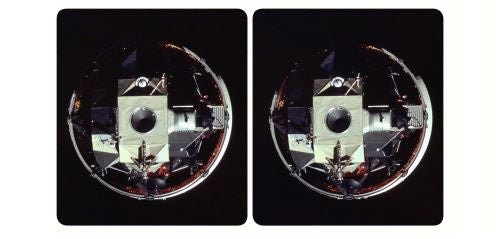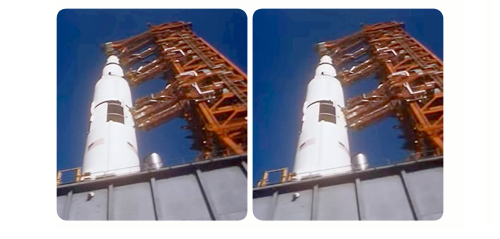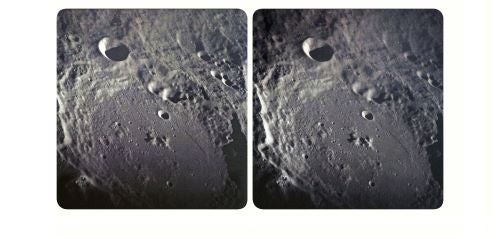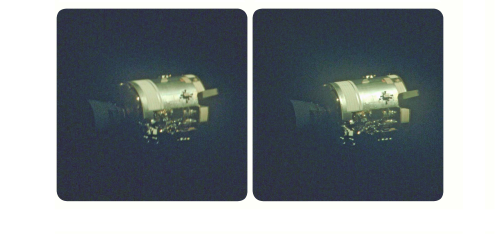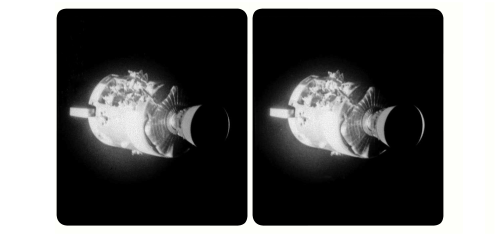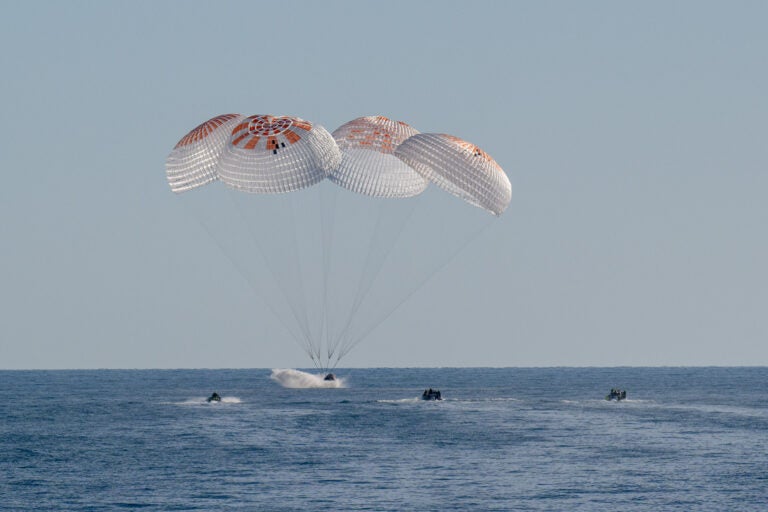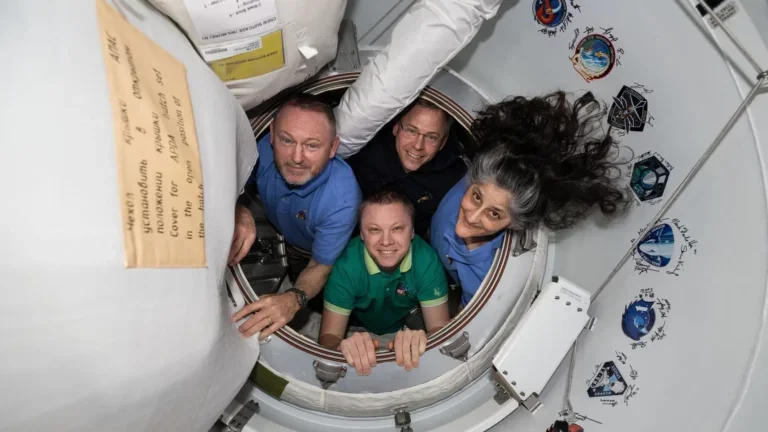Launch for what would be termed Apollo 13 was set for April 11, 1970, and would use the same spacecraft configuration employed for the previous two missions. The crew for Apollo 13 consisted of Commander Jim Lovell, Command Module Pilot Jack Swigert, and Lunar Module Pilot Fred Haise. This was not the original plan, however.
By tradition, the rotation would have composed the crew as Commander Gordon Cooper, Command Module Pilot Donn Eisele, and Lunar Module Pilot Edgar Mitchell. But both Cooper and Eisele were on rocky terms with NASA management at this point in their careers, for different reasons — Cooper had a relaxed attitude toward training, and Eisele had failed to impress with Apollo 7 and was involved in an extramarital relationship. Because of the political issues, Deke Slayton, the Director of Flight Crew Operations, reconfigured the crew to consist of Alan Shepard, Stuart Roosa, and Edgar Mitchell. However, his superiors rejected the plan, believing that Shepard needed more time to recover from ear surgery to be flight ready.
[How to view our 3D images: To view the images with no mechanical assistance, let your eyes relax as you view the photos as though focusing on a point behind them. At first you will see the two images split into four; as your eyes focus at the correct distance, the middle two images will combine to create a single, crisp 3D image. The outer two images will remain on either side of the 3D image and become blurry.]
Lovell, age 42, was an experienced NASA veteran. His naval flight background had served him well as he entered NASA’s second astronaut group, and then commenced a spaceflight career that included Gemini VII, Gemini XII, and Apollo 8, the first trans-lunar flight. With a seat on Apollo 13, Lovell would become the first person to make four trips into space, and the first of three people to fly to the Moon twice. Swigert, age 38, was born in Denver and had become an Air Force pilot, aeronautical engineer, and test pilot before joining the fifth group of NASA astronauts. He studied extensively and became an expert on the Apollo command module, and requested that he become a command module pilot on some mission, which Slayton respected. Fred Haise, age 36, was born in Biloxi, Mississippi, and became an Air Force and Marine Corps fighter pilot and test pilot. Like Swigert, Haise was selected as a member of NASA’s fifth group of astronauts.
All good … at first
With Apollo 13 set for a springtime launch, preparations seemed normal and on schedule. The crafts were named Odyssey (command module) and Aquarius (lunar module, or LM). The mission’s objective was to land in the highlands of the region known as Fra Mauro, named for the 50-mile-diameter (80 kilometers) crater that lay within the area. The region contained unusual geology, and ample amounts of ejecta that had been cast out of the impact that created nearby Mare Imbrium. This would make for a compelling geological area to study.

You can follow mankind’s journey to the lunar surface in our free downloadable eBook: Project Apollo: Reaching for the Moon.
Then, a bang
During the cruise phase, some 56 hours after launch, the crew conducted a live TV broadcast from the capsule and then, some six and a half minutes later, began a variety of tasks. Lovell stowed away the TV camera; Haise secured the LM; Swigert was asked to perform a routine task by the ground controllers. In the service module, he switched on the tank stirring fans in holding containers of hydrogen and oxygen. This periodic exercise mixed the gases, which were at very low temperatures, and allowed the gauges to read the tank contents more accurately. But some two minutes after Swigert did so, the astronauts suddenly heard what they described as a “pretty loud bang.” On gauges, they then observed fluctuations in the craft’s electrical power and the computer-automated firing of attitude control thrusters. At first, for a brief two seconds, the spacecraft lost communications and telemetry with the ground, but the computer reset the antenna, restoring communications.
Lovell, Swigert, and Haise were perplexed, and momentarily believed the LM had been struck by a meteoroid. Scrambling to understand the situation, Lovell uttered the line, “Houston, we’ve had a problem,” which Swigert also stated. Lovell believed the problem was related to an electrical bus, with loss of electrical power on one of the electrical circuits. Then, the crew noticed further alarming troubles. The gauge in oxygen tank No. 2 read “zero.” Soon thereafter, two fuel cells failed. Lovell turned around and looked out the spacecraft window, seeing “some kind of a gas” leaking from the capsule out into deep space. And then, troubling transformed into deeply alarming: Over the next two hours, another oxygen tank, No. 1, slowly depleted its supply of the precious gas, its gauge lagging downward to zero as well. The service module suddenly had no life-giving oxygen gas left.
And if that wasn’t bad enough, the situation turned grave. The command/service module functioned by creating electrical energy from the combination of hydrogen and oxygen into water, but when the first oxygen tank depleted, the only fuel cell still operating also shut down. This now meant that the craft had only a very limited supply of reserve battery power and a small amount of water left. Scrambling, consulting with the ground controllers, the team decided to shut down and temporarily abandon the command module, saving it for an Earth reentry. They also opted to crank up power inside the LM, move themselves there, and employ that portion of the craft, in their words, as “a lifeboat.”
Finding a way home
Once the grim nature of the situation became apparent, Kranz directed personnel at Mission Control to abort the mission. This could be done in a variety of ways, as mission planners had created scenarios for anticipated in-flight problems. The most obvious alternative was the so-called Direct Abort Trajectory, which would require firing the service module’s engines in order to spin up the spacecraft’s trajectory and change its velocity by more than 6,000 feet (1,830 meters) per second. When the analysis occurred, some 60 hours into the flight, it would be possible to set the craft on a safe return flight toward home. However, it would be possible at this stage only if the LM were jettisoned, and this was out of the question because it now served as the life-support system for the crew. So Kranz quickly ruled out the most straightforward, anticipated emergency return option.
Kranz and the support crew on the ground also considered whether the service module engine’s fuel could be burned off, which could be followed by jettisoning the service module, and then using the LM engines designed for a lunar descent to power the craft homeward. But flight controllers worried about ridding the spacecraft of the service module, which would supply valuable heat-shield protection during the Earth reentry. Kranz and his colleagues were also worried about the structural integrity of the service module, and whether its engines would be safe to use in a rescue scenario. So they wished to avoid employing them if at all possible.
With the circumlunar option, more time would be required, but it would be much less risky and would use the Moon’s gravity to propel the spacecraft home. Because the crew were instructed to chart a course that would get them to the region of Fra Mauro, the craft had departed from its initial trajectory prior to the accident. So, in order to initiate a free-return trajectory that would carry them on the proper orbit, they needed to conduct a short burn with the LM descent engine. This burn lasted about 30 seconds.
Troubleshooting in space
Inside Aquarius, the supply of oxygen was critically low, and would be only marginally enough to see the crew back to Earth. On the ground, Kranz plodded along with his team, enlisting Ken Mattingly to help controller John Aaron devise a plan so that Odyssey could be restarted, facilitating the landing on Earth. Kranz simply declared, “Failure is not an option.”
As Aquarius approached the Moon, the astronauts were increasingly uncomfortable. They looked down upon the lunar surface, coming as close as 158 miles (254 km) at closest approach on April 15. Lovell gazed onto the surface and lamented the fact that he and Haise would not walk on the Moon.
The astronauts then focused on the business of returning to Earth. The temperature inside Aquarius was near freezing, making the conditions hard to bear. Moreover, electrical power was running dangerously low, and Haise was feeling increasingly sick. He was experiencing a urinary infection and running a fever, very low in energy and generally feeling terrible. It was a risky and calamitous situation. The lifeboat was becoming a difficult place in which to remain alive.
The psychology of the crew also began to crumble slightly. Swigert suspected that the craft would not be able to return to Earth, and that flight controllers were withholding that fact from the crew. Haise, feverish and ill, felt that Swigert’s nominal experience may have played a role in causing the accident. Before a full-out argument could get rolling, however, Lovell refocused his colleagues on the mission of getting home. (When I interviewed Lovell many years later, he did tell me that the notion that the three of them would become the first “human popsicles in permanent orbit” was weighing heavily on all of their minds.)
Following their closest approach to the Moon’s surface, the crew conducted another burn of the LM descent engine. This had the critical effect of speeding up the return time to Earth by about 10 hours, and also shifting the landing spot from the Indian Ocean to the Pacific Ocean. Kranz and the other controllers felt that, despite the deteriorating conditions, the crew would have sufficient oxygen, electricity, and water to return to Earth on this timetable. This allowed them to avoid a riskier maneuver that would have involved jettisoning the service module. After this key burn of the LM descent engine, which lasted four and a half minutes, only two small course corrections would be made before approaching the home planet.
Lovell later wrote that using the LM as a lifeboat for three astronauts really stretched the limits of what it was intended to do: It was supposed to sustain two astronauts for about a day and a half rather than three astronauts for the four-day return to Earth. The command/service module produced water as a byproduct from its fuel cells. But such was not the case with the LM, which employed silver-zinc batteries, and so within the LM, vitally important electrical power and water were in short supply. Oxygen was less of a concern because the LM had enough to spare in order to repressurize the spacecraft’s atmosphere after each lunar surface activity. But Kranz and the astronauts all wanted to minimize the inherent risks, of course, so they powered down the LM as much as possible to preserve supplies. This also helped them keep communications and life-support functions as stable as possible until nearing reentry into Earth’s atmosphere.
Another looming problem that worsened as the cruise toward Earth continued was carbon dioxide. This, in fact, proved to be a challenging test for both the controllers and the crew alike. Removing carbon dioxide from the LM’s atmosphere would be critical — too much buildup of this gas would prove fatal. Carbon dioxide removal took place via lithium hydroxide canisters, and the LM lacked the number required to remove sufficient carbon dioxide for the return cruise home. Further, the backups were in storage, out of reach, and the command/service module lithium hydroxide canisters were incompatible with the LM. So ground controllers worked out a plan, communicated it to the crew, and the astronauts jury-rigged an outfit to accomplish the task, using hoses to connect the cubical command module canisters to the LM’s cylindrical sockets. They later referred to this arrangement as “the mailbox.”
Back home
As the craft approached Earth, the crew would have to power up the command module from scratch. This had never before been tried during a flight. Given the craft’s weak power availability, controllers Aaron and Mattingly proposed a procedure, but they were uncertain. The extremely cold temperatures within the spacecraft, which dropped as low as 39 degrees Fahrenheit (4 degrees Celsius), meant that water had condensed on surfaces and alarmed the crew and controllers, who thought of potential electrical shorts. But this did not, in the end, turn out to be a problem.
Another risky maneuver loomed. Before approaching Earth’s atmosphere, the crew would have to separate the LM from the command module. Ordinarily, the astronauts would employ the service module’s so-called reaction control system, with its thrusters, to accomplish this. But the craft’s power failure meant this was not operable, and the service module would be gone before the LM anyway. University of Toronto engineers, led by Bernard Etkin and called on by Grumman, worked on the problem for a day and proposed pressurizing the tunnel connecting the LM and the command module just prior to reentry. This, they proposed, would push the two craft away from each other. They communicated their slide-rule calculations to Mission Control, who sent them on to the astronauts. The procedure worked.
With Apollo 13 approaching home, the world watched, bound by hope. The sustained crisis brought people of all nations together as everyone wished for the astronauts’ safe return. News reports became ever more frantic, and despite the constant analysis, all that could now be done was to wait and hope.
As the crew moved toward Earth, they first separated the service module, pushed away from it using the LM’s thrusters, and then photographed the damage on the service module as the two crafts inched apart. They were stunned to see an entire panel on the side of the service module missing. Safely back within the command module, the crew then jettisoned the LM, and, within Odyssey, began reentry into Earth’s atmosphere. The blackout with Apollo 13 lasted six minutes, longer than expected, which heightened the drama on the ground terrifically.
But then, in a flash, communications returned, the craft was spotted, and Odyssey made a splashdown, its chutes out, in the Pacific Ocean, southeast of American Samoa. The amphibious assault ship, USS Iwo Jima, picked up the crew, and the world celebrated. In the end, the most dangerous circumstance in space exploration ended with a triumph. The astronauts missed walking on the Moon, but they lived to walk again on Earth. Lessons from this drama would help fuel the momentum of the Apollo missions to come.
Mission Moon 3-D: A New Perspective on the Space Race, by David J. Eicher and Brian May (with foreword by Charlie Duke and afterword by Jim Lovell), presents the story of the historic lunar landings and the events that led up to them, told through text and three-dimensional images.
Mission Moon 3-D contains new and unique stereoscopic images of the Apollo Moon landings to show what it was like to walk on the lunar surface. The triumph of the Apollo 11 Moon landing takes center stage, with detailed stories and visually stunning images from the lunar missions that followed. The book includes 150 stereo photos of the Apollo mission and space race — the largest group ever published — and presents photos never seen before in stereo.
The book delivers a comprehensive tale of the space race. New stories appear from the astronauts, including Jim Lovell’s anecdotes about the perilous return of Apollo 13.
Mission Moon 3-D also includes a history of the special and musical movements of the 1960s and beyond that transformed the world, from Vietnam and Woodstock to Live Aid. Don’t miss out on this unique treasure.
Mission Moon 3-D is available online at www.MyScienceShop.com
This story is adapted from Mission Moon 3-D: A New Perspective on the Space Race, by David J. Eicher and Brian May, foreword by Charlie Duke, afterword by Jim Lovell, © 2018 by London Stereoscopic Co. and MIT Press, Boston.


